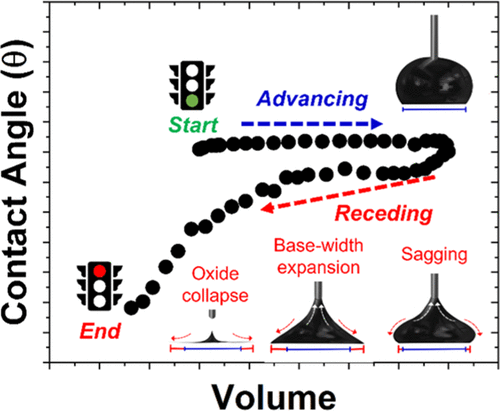Our official English website, www.x-mol.net, welcomes your feedback! (Note: you will need to create a separate account there.)
Are Contact Angle Measurements Useful for Oxide-Coated Liquid Metals?
Langmuir ( IF 3.9 ) Pub Date : 2021-09-07 , DOI: 10.1021/acs.langmuir.1c01173 Ishan D Joshipura 1, 2 , K Alex Persson 1 , Vi Khanh Truong 1, 3 , Ji-Hyun Oh 1 , Minsik Kong 1 , Man Hou Vong 1 , Chujun Ni 1 , Mohanad Alsafatwi 1 , Dishit P Parekh 1 , Hong Zhao 4 , Michael D Dickey 1
Langmuir ( IF 3.9 ) Pub Date : 2021-09-07 , DOI: 10.1021/acs.langmuir.1c01173 Ishan D Joshipura 1, 2 , K Alex Persson 1 , Vi Khanh Truong 1, 3 , Ji-Hyun Oh 1 , Minsik Kong 1 , Man Hou Vong 1 , Chujun Ni 1 , Mohanad Alsafatwi 1 , Dishit P Parekh 1 , Hong Zhao 4 , Michael D Dickey 1
Affiliation

|
This work establishes that static contact angles for gallium-based liquid metals have no utility despite the continued and common use of such angles in the literature. In the presence of oxygen, these metals rapidly form a thin (∼1–3 nm) surface oxide “skin” that adheres to many surfaces and mechanically impedes its flow. This property is problematic for contact angle measurements, which presume the ability of liquids to flow freely to adopt shapes that minimize the interfacial energy. We show here that advancing angles for a metal are always high (>140°)—even on substrates to which it adheres—because the solid native oxide must rupture in tension to advance the contact line. The advancing angle for the metal depends subtly on the substrate surface chemistry but does not vary strongly with hydrophobicity of the substrate. During receding measurements, the metal droplet initially sags as the liquid withdraws from the “sac” formed by the skin and thus the contact area with the substrate initially increases despite its volumetric recession. The oxide pins at the perimeter of the deflated “sac” on all the surfaces are tested, except for certain rough surfaces. With additional withdrawal of the liquid metal, the pinned angle gets smaller until eventually the oxide “sac” collapses. Thus, static contact angles can be manipulated mechanically from 0° to >140° due to hysteresis and are therefore uninformative. We also provide recommendations and best practices for wetting experiments, which may find use in applications that use these alloys such as soft electronics, composites, and microfluidics.
中文翻译:

接触角测量对氧化物涂层液态金属有用吗?
这项工作表明,尽管文献中继续和普遍使用这种角度,但镓基液态金属的静态接触角没有任何用处。在氧气存在的情况下,这些金属会迅速形成一层薄薄的(~1-3 nm)表面氧化物“皮肤”,粘附在许多表面上并机械地阻碍其流动。这种特性对于接触角测量是有问题的,接触角测量假定液体能够自由流动以采用最小化界面能的形状。我们在这里展示了金属的前进角总是很高(> 140°) - 即使在它粘附的基板上 - 因为固体天然氧化物必须在张力下破裂才能推进接触线。金属的前进角微妙地取决于基材表面的化学性质,但不会随着基材的疏水性而强烈变化。在后退测量期间,金属液滴最初会随着液体从皮肤形成的“囊”中抽出而下垂,因此尽管其体积收缩,但与基材的接触面积最初会增加。除某些粗糙表面外,所有表面上的泄气“囊”周边的氧化物销都经过测试。随着液态金属的额外抽取,固定角变小,直到最终氧化物“囊”坍塌。因此,由于滞后作用,静态接触角可以从 0° 到 >140° 进行机械操作,因此无法提供信息。我们还提供润湿实验的建议和最佳实践,这些建议和最佳实践可用于使用这些合金的应用,例如软电子、复合材料和微流体。当液体从皮肤形成的“囊”中抽出时,金属液滴最初会下垂,因此尽管其体积缩小,但与基材的接触面积最初会增加。除某些粗糙表面外,所有表面上的泄气“囊”周边的氧化物销都经过测试。随着液态金属的额外抽取,固定角变小,直到最终氧化物“囊”坍塌。因此,由于滞后作用,静态接触角可以从 0° 到 >140° 进行机械操作,因此无法提供信息。我们还提供润湿实验的建议和最佳实践,这些建议和最佳实践可用于使用这些合金的应用,例如软电子、复合材料和微流体。当液体从皮肤形成的“囊”中抽出时,金属液滴最初会下垂,因此尽管其体积缩小,但与基材的接触面积最初会增加。除某些粗糙表面外,所有表面上的泄气“囊”周边的氧化物销都经过测试。随着液态金属的额外抽取,固定角变小,直到最终氧化物“囊”坍塌。因此,由于滞后作用,静态接触角可以从 0° 到 >140° 进行机械操作,因此无法提供信息。我们还提供润湿实验的建议和最佳实践,这些建议和最佳实践可用于使用这些合金的应用,例如软电子、复合材料和微流体。
更新日期:2021-09-21
中文翻译:

接触角测量对氧化物涂层液态金属有用吗?
这项工作表明,尽管文献中继续和普遍使用这种角度,但镓基液态金属的静态接触角没有任何用处。在氧气存在的情况下,这些金属会迅速形成一层薄薄的(~1-3 nm)表面氧化物“皮肤”,粘附在许多表面上并机械地阻碍其流动。这种特性对于接触角测量是有问题的,接触角测量假定液体能够自由流动以采用最小化界面能的形状。我们在这里展示了金属的前进角总是很高(> 140°) - 即使在它粘附的基板上 - 因为固体天然氧化物必须在张力下破裂才能推进接触线。金属的前进角微妙地取决于基材表面的化学性质,但不会随着基材的疏水性而强烈变化。在后退测量期间,金属液滴最初会随着液体从皮肤形成的“囊”中抽出而下垂,因此尽管其体积收缩,但与基材的接触面积最初会增加。除某些粗糙表面外,所有表面上的泄气“囊”周边的氧化物销都经过测试。随着液态金属的额外抽取,固定角变小,直到最终氧化物“囊”坍塌。因此,由于滞后作用,静态接触角可以从 0° 到 >140° 进行机械操作,因此无法提供信息。我们还提供润湿实验的建议和最佳实践,这些建议和最佳实践可用于使用这些合金的应用,例如软电子、复合材料和微流体。当液体从皮肤形成的“囊”中抽出时,金属液滴最初会下垂,因此尽管其体积缩小,但与基材的接触面积最初会增加。除某些粗糙表面外,所有表面上的泄气“囊”周边的氧化物销都经过测试。随着液态金属的额外抽取,固定角变小,直到最终氧化物“囊”坍塌。因此,由于滞后作用,静态接触角可以从 0° 到 >140° 进行机械操作,因此无法提供信息。我们还提供润湿实验的建议和最佳实践,这些建议和最佳实践可用于使用这些合金的应用,例如软电子、复合材料和微流体。当液体从皮肤形成的“囊”中抽出时,金属液滴最初会下垂,因此尽管其体积缩小,但与基材的接触面积最初会增加。除某些粗糙表面外,所有表面上的泄气“囊”周边的氧化物销都经过测试。随着液态金属的额外抽取,固定角变小,直到最终氧化物“囊”坍塌。因此,由于滞后作用,静态接触角可以从 0° 到 >140° 进行机械操作,因此无法提供信息。我们还提供润湿实验的建议和最佳实践,这些建议和最佳实践可用于使用这些合金的应用,例如软电子、复合材料和微流体。



























 京公网安备 11010802027423号
京公网安备 11010802027423号